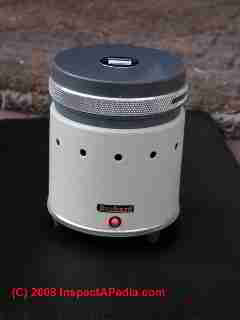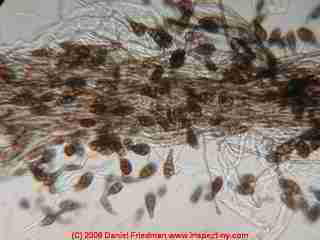 Validity of Popular Mold Test Methods
Validity of Popular Mold Test Methods
Questionable vs Good Practices in Mold & Dust Sampling
- POST a QUESTION or COMMENT about mold test validity & good building mold contamination investigation practices
Here we describe factors that affect the accuracy of various mold, dust & similar environmental testing methods used in buildings.
We describe or question the validity of nearly all of the popular mold testing methods currently in use, pointing out the strengths and weakness of each approach to mold sampling in the indoor environment, beginning with air sampling for airborne mold levels indoors.
The mold testing methods comparison study reported here presents a summary and critique of some popular methods used to examine indoor air quality to test for presence or absence of problematic levels of toxic or allergenic mold or other bioaerosols.
We critique specific "testing" or "sampling" methods used to "test" buildings for mold in the course of a building investigation. The appropriateness of testing at all is discussed on this and other pages at this website.
InspectAPedia tolerates no conflicts of interest. We have no relationship with advertisers, products, or services discussed at this website.
- Daniel Friedman, Publisher/Editor/Author - See WHO ARE WE?
Critique of Contemporary Indoor Mold Sampling/Collection/Testing Methods
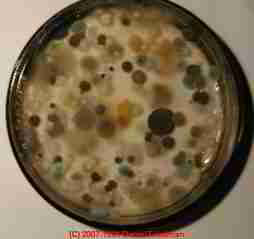 15th Annual North Carolina/South Carolina
15th Annual North Carolina/South Carolina
Environmental Information Association Technical Conference
Myrtle Beach, SC
Daniel Friedman 23 September 2005, Updated 2/8/2012 & 2017/08/01 & 2019/02/12
The contents of this series of article originally appeared in a more abbreviated form at the 15th Annual North Carolina/South Carolina Environmental Information Association Technical Conference, Myrtle Beach, SC, by Daniel Friedman, 23 September 2005. The bottom of each article page shows the latest revision date.
We will discuss: Tape sampling for mold - sampling location is critical. Vacuum samples - useful for some materials & surfaces & for insulation, not valid for building cavities. Cultures to "Test for Mold" - unreliable.
Swab sampling - damages samples. PCR methods for Mold Identification - accurate if you already know what you're looking for.
Article Contents
- IS MOLD TESTING NEEDED AT ALL?
- IS YOUR MOLD EXPERT REALLY AN EXPERT?
- TYPES OF AIR SAMPLES for DUST or MOLD
- AIR SAMPLING SHORTCOMINGS
- QUESTIONABLE AIRBORNE MOLD COUNTS
An illustrated power-point version of this document is at InspectAPedia.com/mold/Mold_Test_Validity_Class.php - that copy involves larger files of images and data - if you are viewing this document from a low-speed line you should stick with this text version.
First, should we be testing for mold at all?
If you see mold on indoor surfaces, NO mold testing is needed to confirm that mold is present in a this building and that cleanup is needed. But if a large remediation project is planned, tests may be needed for project control.
See MOLD / ENVIRONMENTAL EXPERT, HIRE ?
for a discussion of when it is or is not appropriate, justified, and ethical to hire a mold consultant to inspect, diagnose, and advise about mold contamination in a building.
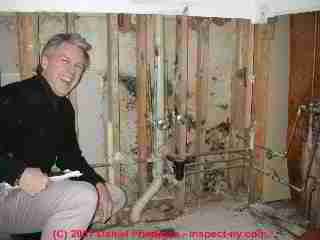 An IAQ or "mold investigator" cannot reliably identify a mold genera or species growing on a building
surface by the naked eye. Despite the recent public fear created by media
attention, including a now-refuted "Toxic black mold" Stachybotrys
chartarum study involving infant illness and death, it is simply not the
case that "black mold" in buildings is necessarily a danger to
occupants.
An IAQ or "mold investigator" cannot reliably identify a mold genera or species growing on a building
surface by the naked eye. Despite the recent public fear created by media
attention, including a now-refuted "Toxic black mold" Stachybotrys
chartarum study involving infant illness and death, it is simply not the
case that "black mold" in buildings is necessarily a danger to
occupants.
In fact, having investigated many buildings quite carefully, we assert that in most cases the "black mold" that you see in buildings is most often an "indicator organism" telling you that conditions are right for mold formation.
Our photo (left) shows Craig Balchunas during an environmental inspection.
We have often found more problematic molds in such properties, such as species of Aspergillus sp. or Penicillium sp. which are airborne, travel in the building, and are more likely to be bothering the occupants than a large, sticky, non-easily-airborne spore like S. chartarum.
These harder to see, often light-colored molds, are quite often missed entirely by inexpert owners and amateur "mold inspectors" who go on to collect, over-report the occurrence of, and react to the "black stuff."
One result has been unnecessary expense for "mold testing" and in some cases unnecessary mold remediation. Some of our articles, as well as writing by others who study this field, address these problems and offer help in deciding what level of trouble and expense are appropriate.
In any case, mold in a building should be cleaned-up, and large amounts might require professional inspection and advice. Before doing anything drastic or costly, get some competent advice.
Opinions Expressed in This Article
This is a working document and our study of indoor air quality, mold testing, and other sampling methods is ongoing. These views are undergoing and are subject to peer review and revision. (Critique from any reader is welcome).
Trained in building science, aerobiology, and forensic microscopy, we perform on-site building investigations to evaluate the need for and extent of mold remediation in buildings in order to give mold remediation and prevention advice.
Also trained in mold and other particle identification (forensic microscopy), we operate our own aerobiology laboratory where samples, collected during an investigation, are examined.
In the course of our field surveys we often collect multiple samples even at the same surface or building area, in order to study the relative effectiveness and consistency of the various methods, just as we test and compare other tools used to find hidden moisture and similar problems.
(These extra samples, collected for purposes of scientific study, are not billed to our client.)
Our opinions about the usefulness of various methods derive from both study by other experts and by our own ongoing field and laboratory testing.
Does everyone need to hire an "expert" like me to examine their home? Of course not. This article offers help in choosing mold sampling and testing methods and devices.
Other articles at our website offer help in determining
when it's appropriate to hire an expert.
See MOLD / ENVIRONMENTAL EXPERT, HIRE ?
The Minnesota Department of Health has useful advice [ www.health.state.mn.us/divs/eh/indoorair/contractors.pdf ] about hiring an investigator too.
Consultant certification - who's an "expert" and do you even need one?
Where the extent of mold damage and/or the risk to building occupants justifies a professional survey, the inspection, sampling and testing performed, the laboratory determination of sample contents, and mold cleanup must be performed competently, lest the building owners/occupants face an unexpected health risk (someone makes a mess of problematic mold) or cost (a poor remediation plan or bad clearance testing leaves a mold problem and the work has to be done all over again).
Whoever performs sampling or testing needs to use effective methods for inspection and testing.
For professional inspections, education and experience are required for this work as substantial costs and the health of present and future building occupants can be at risk. Consumers should review experience and education of whomever they hire to survey a building or to clean up an environmental problem.
Regrettably various mail-order "certifications" are available which are confusing to consumers, and even within organized professions such as industrial hygiene, environmental inspection firms, engineering firms, and home inspection companies, individual training, experience, and depth of knowledge vary enormously.
Consumers hiring an inspector or remediation company should consider the education, experience, and track record of people they may employ and should not rely only on a professed "certification."
(Years ago our dog Katie became a "certified inspector," and received a full diploma from a national "certification" agency.
Try going to the "certifying" agency's website to see if, for simply mailing in a fee, or perhaps taking a weekend course, you, too, could become "certified" as a "mold remediator" or "environmental inspector.")
The CIH designation is a real credential for industrial health investigations (in industry) as is P.E. "real" for certain specialties such as engineering design or forensic engineering.
But some CIH's and P.E.'s are not familiar with building failures and leak tracing, and may match other "mold investigators" who are not familiar with mycology, aerobiology, air and particle movement indoors, microscopy, chemistry, proper ways to use equipment, how to evaluate the expertise of their "mold lab," or even what mold looks like.
The Pan American Aerobiology Association [ http://www.paaa.org/ ] has recently completed and turned over to an independent testing agent [ http://www.paacb.org ] a national examination specifically to test the competence of people identifying fungal spores, a test which was offered beginning in 2004.
Look for this and other pertinent professional associations or certifications provided they are from "real" professions and professional associations. And look at the background and experience of the investigator. AIHA is also interested in further investigator and lab certifications.
Mold "Testing" - A Guide to Good Practices in Mold "Testing": Examining the Validity of Current Indoor Mold Sampling Techniques
A Guide to Using Air Samples to Test Buildings for Harmful or Toxic Mold
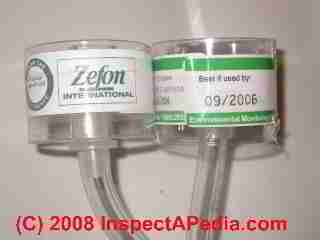 A collection device, slide, cassette, or tape are used with a calibrated air pump to collect airborne particles.
A collection device, slide, cassette, or tape are used with a calibrated air pump to collect airborne particles.
We am not referring to culture plates which rely on passive collection or settlement of particles as these have even worse inaccuracies and errors than the reservations we describe about active air sampling described here.
Some common examples of air samplers include:
- Impaction samplers (Burkard™,
Allergenco™)
collect airborne particles through a venturi -slit onto a prepared microscope slide using a equipment incorporating a calibrated air pump and a static or moveable slide permitting single-use or time-lapse sampling.
Photos of these two sampling devices are shown just below. - Cassette samplers
(Air-o-Cell™) also often called spore traps,
use a patented 37mm cassette connected to a calibrated pump (typically at 15 lpm).
The cassette is used to collect airborne particles through a venturi -slit onto a proprietary media on a cover-slip which is in turn mounted onto a microscope slide in the laboratory. (Photo above) - Cassette samplers using an
MCE filter
cassette connected to a calibrated pump.
The filter can be cleared and examined microscopically (qualitatively, counting is tough except with the BI -Air™), or used to prepare a culture, or both. - Cassette-like samplers use a
calibrated pump
connected to a patented stainless steel venturI -device which accepts a microscope slide prepared with a collection media. - Anderson-type pollen, mold spore & airborne particle samplers
which collect particles directly onto a culture dish - for "viable sampling" to "test" for mold.
Culture samples may be useful in some cases to better identify or to speciate mold which has already been found in a large reservoir. Otherwise it has limitations we discuss elsewhere in this document. - Anderson-type impaction
samplers
which collect particles on tape wrapped around on a drum or Rotorod samplers which collect particles on glass rods are used for outdoor pollen and spore counting and reporting in the IAAA allergy network.
They are not well-suited for indoor building assessment though some folks use the high-error rotorod sampler indoors.
See AIRBORNE PARTICLE TEST SAMPLING CASSETTE STUDY.
Shortcomings of air sampling for mold
Common test conditions cause very wide variation in mold test results
Airborne particle levels vary enormously from minute to minute in a building,
a fact that is not considered in airborne indoor mold spore counts.
The sources of this variation or even the observation of their condition (windows open or shut, fans on or off) are rarely recorded during indoor air tests for mold.
As a "mold test" for the presence or absence of a mold problem in a building, a negative air sample result is of little confidence.
As a measure of "mold exposure" quantitative analysis (spores/cubic meter) is invalid unless long-term time-weighted average measurements are made under all varying building conditions. While this is an important diagnostic tool, and one which we apply regularly, it cannot be relied alone on in the way some investigators would use it: dashing into a building and grabbing an air sample.
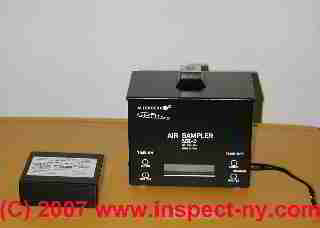 Air sampling as a "pass/fail" or
"present/absent" test for mold in buildings is unreliable as a
"mold test." Many variables cause a wide range of particle levels in
air over short intervals.
Air sampling as a "pass/fail" or
"present/absent" test for mold in buildings is unreliable as a
"mold test." Many variables cause a wide range of particle levels in
air over short intervals.
However this method has a place in a thoughtful building investigation: air sampling can be useful as a background check for the possibility that there is a large reservoir source which has not yet been found in a building.
But a negative result is of absolutely no confidence, and quantitative work (spores/cubic meter) is invalid unless long-term time-weighted average measurements are made under all varying building conditions.
Our own time-lapse sampling (such as using the Allergenco Mark II time lapse impaction sampler shown at left) proves that indoor airborne mold and other particle levels easily vary by a factor of 10,000 due to common variations in building conditions such as fan on off, human activity, mechanical disturbance of moldy stuff, etc.
While this is an important tool it cannot be relied on in the way most "inspectors" would use it, dashing into a building and grabbing an air sample.
See MOLD in AIR: QUANTIATIVE ANALYSIS below for an elaboration
ACCURACY OF AIR TESTS for MOLD for more details about the accuracy of air tests for mold.
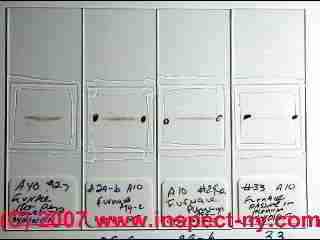
Summarizing these mold test shortcomings,
- Airborne mold spores and other particle levels vary significantly indoors from minute to minute
as well as from area to area depending on human activities as well as use of fans, vents, windows, doors, and even lighting equipment.
You can see in our photo at left that in a single building location small variations in sampling conditions (like waving a notebook in the air) can produce enormous differences in the number of particles collected.
More detail is
at MOLD LEVEL IN AIR, VALIDITY. - Spores are collected but not spore producing conidiophores,
hyphae and other components are collected, making identification incomplete and more difficult than with tape or cultured samples. - Spores are desiccated and may be damaged
by the collection method, interfering with culture efforts if this follow-up step is needed.
In sum, air sampling is useful as a background screen for the possibility that there is a large reservoir source which has not yet been found in a building, and may be useful to compare relative particle levels between a problem area and a control area, or in an area before and after cleaning.
But a negative result (no problem mold found) when performing air sampling is one in which you cannot have high confidence unless it is accompanied by a number of other critical building visual inspections and other test methods.
Independent from spore counts, a qualitative analysis of an air sample by an expert technician can provide compelling evidence of a nearby problem mold reservoir in certain cases, for example if the indoor sample contains long chains of Penicillium or Aspergillus spores.
These spore chains are so fragile that they break apart quickly while traveling through the air. So spore chains found in (a pre-remediation) indoor sample, even if the total count is low, deserve some further thinking and investigation.
Measuring Airborne Mold - Mold in Air: Quantitative Analysis - "Spore counts"
Examining particles on a slide to count Mold spores/Meter3 of air, Mold Spores/M2 of surface area, or Mold CFU's - colony-forming units is a common practice in building investigations. These measures can be used to describe the results of some sampling or "mold testing" methods in building.
While there is no fixed (nor fix-able) standard of absolute allowable "spore counts" in air (we'd need a standard for every genera and species by toxicity, weight, mobility, etc.), investigators have now seen so many moldy and not-moldy buildings, and complaint and non-complaint areas that it's reasonable to have some general guidelines about what levels are probably a problem and what levels may not be a problem.
What Are Acceptable Airborne Mold Counts?
While there is no well-established quantitative standard for fungal spores on surfaces or in air, mold contamination is considered present in a building when the total mold spore concentration per cubic meter of air is above 10,000. (Baxter, ETS).
Acceptable levels for individual species vary since species toxicity varies widely as does spore size, weight, and other features which affect risk to building occupants.
See MOLD EXPOSURE STANDARDS
and
see MOLD EXPOSURE STANDARDS for details.
E.g. Aspergillus/Penicillium in a "clean" residential building study was at a mean of 230, in buildings known to have a moisture or flooding problem it was at 2235 and in mold contaminated buildings the figure was 36,037.
Surface samples
of mold: the presence of toxic or allergenic mold as a dominant particle in any sample (surface or air) is usually a cause for further investigation or remediation.
The presence of incidental occurrences of toxic or allergenic material in surface samples requires interpretation in light of other building conditions, type of particle (spore chains), and other factors. For example, in a pre-remediation building where occupants have building related complaints and mold contamination is suspected, even a modest indoor level of 500 spores/M3 of air might suggest a problem if those spores formed a high percentage of the total indoor spore count and only a low percentage of the corresponding outdoor spore count taken as a control.
Our own field experience is similar to the counts suggested by Baxter. Since indoor environments in the U.S. and many other parts of the world are similar in conditions and often in building materials, it is likely that these levels are not very dependent on region of the country.
Watch out: interpret all quantitative data with great caution. Individual samples of particles in air show tremendous variation from minute to minute, making "ok" test results a thing to view with care. In situations of particular risk additional or periodic testing should be considered.
However, because indoor conditions of mechanical disturbance, ventilation, occupancy, and use vary widely over short intervals of just a few minutes, an indoor "mold spore count" is at high risk being inaccurate, incoherent, and confounding.
Recipients of such reports are may not realize the distinction between highly precise results (lots of decimal places) and results which are fundamentally accurate or inaccurate, depending on the design of the sampling plan and the variation in building conditions during the sampling interval.
Unless there is good experimental design, quantitative results are precise (lots of decimal places in the answer) but almost certainly wrong (off by a factor of thousands) as a characterization of a building.
Therefore quantitative studies are most useful as part of a more broad qualitative approach, indicating either relative differences in mold levels between a control area and a problem area or the relative change in building conditions before and after cleaning.
They are much less reliable as an absolute pass/fail criteria. Other substantial quantitative report issues other than accuracy include wide variation among labs in counting and skill levels, and more interestingly, the lack of and virtual impossibility of establishment of valid quantitative standards for mold exposure.
For example, two different particles have different toxicity, different air movement; two of the same particle can vary in toxicity depending on supporting growth surface.
Shortcomings of Quantitative Analysis of Mold Spores in Air
- Quantitative Analysis producing low results is unreliable:
Building conditions vary enormously, causing huge variations in what particles may be found in the air at any given time. Our own time-lapse sampling suggests that particle levels vary by a factor of at least several orders of magnitude due to common variations in building conditions such as fan on off, human activity, mechanical disturbance of moldy stuff, etc. - Quantitative results which are superficially similar
between indoors and outdoors may be misleading: An outdoor "Pen/Asp" count of 500 spores/M3 may have captured a genera or species which is completely different from a corresponding indoor "Pen/Asp" count which also found 400 spores/M3 . - Quantitative results which seem "low"
and qualify as a "clean building" may be misleading: a lab reporting an outdoor "Pen/Asp" count of 700 and an indoor "Pen/Asp" count of 450 may look like an acceptably "clean" building - the indoor count is "below the outdoor count."
But suppose in fact the outdoor "Pen/Asp" is actually an unidentified amerospore, or a basidiomycete mis-classified, or is a common outdoor species of Penicillium, while the indoor "Pen./Asp" is actually representing Aspergillus niger?
- This is an argument for doing some
subsequent culture work or better lab microscopy
(Aspergillus niger can be identified by light microscope alone.) In this case the "low" level of 450 spores may in fact be a weak indicator of a large problem mold reservoir in the building.
...
Reader Comments, Questions & Answers About The Article Above
Below you will find questions and answers previously posted on this page at its page bottom reader comment box.
Reader Q&A - also see RECOMMENDED ARTICLES & FAQs
On 2020-02-2 - by Kurt Claus said: better to prevent than to deal with the consequences
Hey, thanks for sharing this.
Of course, it is better to prevent than to deal with the consequences. But if it’s too late, and a problem with mold has already appeared, you need to act without delay. Many underestimate the danger of mold, and as a result, they get persistent and serious health problems.
Regards,
Kurt
On 2019-07-31 by Matt - Mold is everywhere, and it needs oxygen, water, and a food source (cellulose) to grow.
Mold is everywhere, and it needs oxygen, water, and a food source (cellulose) to grow. The picture doesn’t look as bad as most. Clean the surface and apply a nonporous paint to encapsulate it. The chances of something like this causing an indoor air quality problem are near zero.
You’re bringing in more spores through your front door than are migrating through the OSB, insulation, and drywall at this location.
Everyone reacts differently to mold, which is why there are no airborne standards by the EPA and no OSHA exposure limits. I could bathe in thousands of spores, whereas you could breathe in one spore you are sensitized to and have an allergic reaction.
As someone who works in the industry and also owns a side business for occupational safety/industrial hygiene, I can assure you that many companies take advantage of consumers with regard to mold.
It is the new asbestos, and a lot of money can be made. It is unfortunate since many people are simply uneducated on mold. The color of mold is often dictated by what it is consuming. Black mold can be a variety of species, not necessarily stachybotris.
When you find mold, clean it or remove it If it can’t be cleaned. Fix the water source.
For sensitized populations, you may need to go further and introduce engineering controls like HEPA filtration and keeping the home positive in pressure to the outside. For 99% of people, this is overkill.
On 2019-07-31 1 - by (mod) - remove mold and fix the cause
Thank you for the comment, Matt,
I agree with you completely. In fact your wording is almost exactly the same as what you will see in my remarks throughout this article series.We remove moldy materials that can't be cleaned, clean services that can be cleaned, and correct the cause.
You will also read that in perhaps most cases, I argued that mold testing is not necessary. It certainly doesn't change the clean-up procedure that's needed.
There are some limited uses for mold testing such as to establish or prove that mold contamination in a building area came from a cleanup or proper containment and occasionally for medical diagnostic purposes. But it's not generally needed for mold remediation.
On 2017-01-26 by Beardsley Building Development - what's a safe moisture reading for interior office gypsum board
Question:
What is the safe moisture reading for interior office gypsum board walls to prevent mold growth?
On 2017-01-26 - by (mod)
The absolute limit would probably be 18% moisture content in drywall.
However, in my opinion that's not a safe number since building conditions vary and that means that at other times the moisture level would probably reach into a level that would invite mold growth.
Usually interior drywall in a building that has been heated or air-conditioned and occupied for weeks or months or longer, the moisture level will be in the three or 4% range.
On 2016-05-18 by Sarah - there is NO way to accurately test for mold
Hi there - I have done quite a bit of reading on your website recently and it seems to me, if you are correct, there is NO way to accurately test for mold. Let me explain why I am interested. I recently bought a house.
Before we moved in we had mold testing because I am severely allergic to mold and have had to sell one house a year after buying it because I was allergic to it (it was an older house that inevitably was going to allow for some mold growth in the basement).
The inspector was VERY negative. Said he finds mold in almost all houses.
He did a visual inspection and found no evidence of moisture intrusion.
He took one air sample on each floor and they all came back fine.
Since moving in I have had some allergy issues. I have pulled siding off and checked the window flashings (dry as a bone), drilled into walls to examine the insulation and drywall (also nothing), and kept on eye on things for signs of moisture when it rains. I have come up dry each time (which is good I suppose).
But the fact remains that I don't feel well. I am hesitant to hire another inspector or any mold professional.
In my previous home I had one guy tell me we had black mold growing openly on the rafters of our basement and that we had a huge problem and quoted us $20,000 to clean it up without doing
The second person told us there was no problem at all. When we sold the house we disclosed that there was some moisture in the basement that needed maintenance.
The house sold fine. The buyer's inspector was probably most accurate in saying that problem was somewhere between ideal and a tragedy. Then I paid over $500 for mister "I'm the world's foremost expert on mold..
I WILL find mold in this house" to come in and tell me there was no mold in my new house only to start having allergy symptoms that would indicate there is. You can imagine I am more than a bit skeptical when it comes to "mold inspectors."
At least in Ohio where there is little regulation on the inspection business in general. So what on earth am I supposed to do? I really cannot afford to hire another professional to come out and look around and charge me several hundred dollars to find nothing, but you argue against basically any kind of testing I can do on my own to help find the source. Any suggestions?
On 2016-05-30 - by (mod) - **Just** "testing" for mold is not useful and some "tests" for mold are fundamentally wrong and totally unreliable.
Sarah:
There is no simple test that eliminates risk of a hidden mold reservoir, and a mold test without an expert and thorough building inspection would then be very unreliable: if it finds mold it doesn't tell you the reservoir location so you still end up spending again to dig further; if it doesn't find mold you can't trust it.OPINION: It is reasonable to say that if testing finds a very high level of airborne mold spores there's likely to be a nearby problem and an expert lab technician might also spot low levels of particularly-meaningful particles like Aspergillus spore chains that can indicate a probable problem even if the total level detected is small.
But there is too-high probability that mold testing simply misses an important mold contamination reservoir for any of a variety of reasons.
So a thorough visual inspection for conditions that cause mold, evidence of leaks, leak history, moisture traps, plumbing backups, etc. is very useful.
Only an idiot would say "there is no mold" in a building. There is always mold in building air - coming along with air, people, pets, and stuff that enter.
No experienced inspector would guarantee there is no hidden mold reservoir either unless she totally demolishes the building.
But what we can do, when there is no actual visible mold reservoir, is
identify (based on building history, materials, construction details, client interview and similar data) the highest-risk areas in the building,
investigate those areas, invasively if necessary
sufficiently to say that
- we did or did not find mold that deserves cleaning and removal
- there is (based also on occupant vulnerability) justification for further demolition and invasive inspecting
What I argue is that **Just** "testing" for mold is not useful and some "tests" for mold are fundamentally wrong and totally unreliable.
On 2016-03-27 by Jason Earle - hidden mold in building cavities is likely to be missed in a "mold test"
I agree with [the moderator]. Also, even if you collect spore trap-type air samples the correct way, and use a quality lab, mold in a wall will not show up.
Even if there's visible mold, sometimes you can get a false negative, especially with Stachybotrys and Chaetomium.
Here’s what the Institute of Medicine had to say in a study titled “Damp Indoor Spaces and Health” published in 2004, on page 66: “Fungal types vary remarkably in their capacity to produce and release spores. Penicillium and Aspergillus typically produce large numbers of spores that are easily released into the air. Stachybotrys and Chaetomium are examples of fungi that produce fewer spores and release them only occasionally.
Penicillium and Aspergillus spores are regularly found in air samples, and Stachybotrys and Chaetomium spores are rarely found in the air, even in environments where they are growing (Andersen and Nissen, 2000)”
And to answer your questions about whether or not it can be making your wife sick, the answer is yes, but there is no way to know for sure. About the MVOCs, all actively growing molds produce some form of MVOC.
Although I believe much of the illness caused by mold is related to the MVOCs, more than the mycotoxins, the science is sketchy. The bottom line is that mold and dampness indoors is not good. Fix the source, clean up the mold and scrub thy air.
On 2016-03-27 2 - by (mod) -
Thanks Jason, I agree entirely with the points you made. I've seen
- 1-4 orders of magnitude in airborne spore level depending on how an "air test" is conducted,
- dominant molds detected in an air test that in no way represented the dominant or most extensive mold contamination source in the building
- large variations in spore release, as you said, can be due to variations in moisture level in a building (and of course mold genera/species) as well as other conditions that cause fungi to hold on-to or to release their spores. So even for an individual mold species, the spore release rate varies enormously as conditions change - from hard to detect to dominant in air samples.
On 2016-01-06 by Dave - air tests in our home completely missed a big mold reservoir in the ceiling
In 2014 a drain pipe leaked a good amount of water into the ceiling of a bedroom of the home in which I am a tenant. Prior to that (4-5 years ago), rain water came in through the ceiling of the adjacent bathroom.
My wife has been sick for two years with over a dozen symptoms associated with mold exposure - though until now we never realized it could be from mold.
Fearing mold in the ceilings/walls, two separate air tests were performed at my home and both came up as "not elevated" with pen/asp making up 86% of the sample. Is that high (outdoor sample came up in the mid-50% range). Not convinced that air quality tests alone told the entire story, I cut open the ceiling in the bedroom and peeled off the backing of the sheetrock which clearly showed mold growth.
I sent this sample into a certified lab for testing. Tests came back positive for Stachybotrys. ion is whether the stachybotrys in the ceiling (which, presumably, began growing in 2014 in the tested bedroom, and potentially earlier in the bathroom) could have contributed to my wife's declining health.
Even though Stachybotrys didn't show up in the air samples, can't it still produce MVOCs (?) that are harmful. Thanks for your guidance!
On 2016-01-07 0 - by (mod) - signs of in-valid mold "testing"
Dave, the testing that you have had performed does not sound valid, reliable, nor correctly performed. Air testing without a thorough visual inspection is not reliable especially when the results are negative.
There are other errors in the information that you have been given, or at least misunderstandings.
If water leaked into the building ceilings and walls it is very possible that there is a large but hidden mold contamination. It would be very unusual for there to be just one or two mold species present in those conditions. In my opinion from what you have written it sounds as if an expert on site inspection is warranted. Keep me posted.
...
Continue reading at MOLD TEST PROCEDURES or select a topic from the closely-related articles below, or see the complete ARTICLE INDEX.
Or see these
Recommended Articles
- ACCURACY OF AIR TESTS for MOLD
- ACCURACY vs PRECISION of MEASUREMENTS
- AIRBORNE PARTICLE SIZE DEFINITIONS & TYPES
- AIRBORNE PARTICLE SIZE TABLE
- INDOOR AIR QUALITY METHODS COMPARED for a more comprehensive collection information about mold test methods
- MOLD EXPOSURE RISK LEVELS
- MOLD EXPOSURE STANDARDS
- MOLD INVESTIGATION REPORTS
- MOLD LAB REPORTS
- MOLD LEVEL REPORTING
- MOLD TEST PROCEDURES
- MOLD TESTING METHOD VALIDITY
Suggested citation for this web page
MOLD TESTING METHOD VALIDITY at InspectApedia.com - online encyclopedia of building & environmental inspection, testing, diagnosis, repair, & problem prevention advice.
Or see this
INDEX to RELATED ARTICLES: ARTICLE INDEX to MOLD CONTAMINATION & REMEDIATION
Or use the SEARCH BOX found below to Ask a Question or Search InspectApedia
Ask a Question or Search InspectApedia
Try the search box just below, or if you prefer, post a question or comment in the Comments box below and we will respond promptly.
Search the InspectApedia website
Note: appearance of your Comment below may be delayed: if your comment contains an image, photograph, web link, or text that looks to the software as if it might be a web link, your posting will appear after it has been approved by a moderator. Apologies for the delay.
Only one image can be added per comment but you can post as many comments, and therefore images, as you like.
You will not receive a notification when a response to your question has been posted.
Please bookmark this page to make it easy for you to check back for our response.
IF above you see "Comment Form is loading comments..." then COMMENT BOX - countable.ca / bawkbox.com IS NOT WORKING.
In any case you are welcome to send an email directly to us at InspectApedia.com at editor@inspectApedia.com
We'll reply to you directly. Please help us help you by noting, in your email, the URL of the InspectApedia page where you wanted to comment.
Citations & References
In addition to any citations in the article above, a full list is available on request.
- Craig Balchunas is an ASHI member, and a licensed New York home inspector and environmental and mold test inspector who previously practiced in Newburgh, NY.
- In addition to citations & references found in this article, see the research citations given at the end of the related articles found at our suggested
CONTINUE READING or RECOMMENDED ARTICLES.
- Carson, Dunlop & Associates Ltd., 120 Carlton Street Suite 407, Toronto ON M5A 4K2. Tel: (416) 964-9415 1-800-268-7070 Email: info@carsondunlop.com. Alan Carson is a past president of ASHI, the American Society of Home Inspectors.
Thanks to Alan Carson and Bob Dunlop, for permission for InspectAPedia to use text excerpts from The HOME REFERENCE BOOK - the Encyclopedia of Homes and to use illustrations from The ILLUSTRATED HOME .
Carson Dunlop Associates provides extensive home inspection education and report writing material. In gratitude we provide links to tsome Carson Dunlop Associates products and services.


